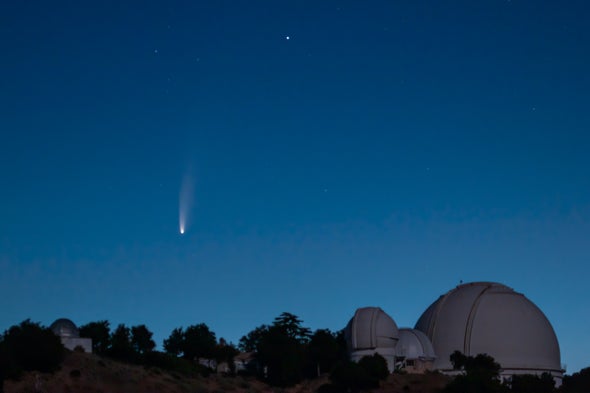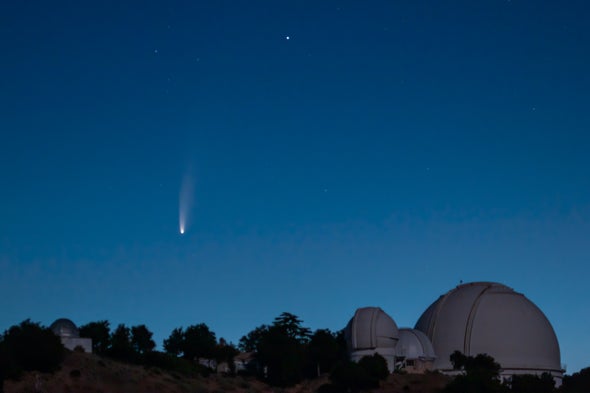Already visible to the naked eye, the object may soon brighten to create the greatest celestial light show in decades—or it could simply fade away

This month a cosmic visitor is gracing the skies. A comet swept past the sun on July 3, and it has since become visible to the naked eye. The rare opportunity to glimpse the chunk of ancient ice from the outer solar system should continue next week, when astronomers hope it will become even brighter.
Scientists using the Near-Earth Object Wide-Field Infrared Survey Explorer (NEOWISE) space telescope first spotted the comet as it hurtled toward the sun on March 27. Informally dubbed NEOWISE after the telescope but officially labeled C/2020 F3, the comet gradually brightened as sunlight and solar wind caused it to release gases and form a tail. In early June it reached the far side of the sun, as seen from Earth. The resulting glare prevented astronomers from observing the comet for several weeks. By late June, however, it swam back into the optics of another space telescope, the Solar and Heliospheric Observatory (SOHO). Its fate was still unclear, however: Would Comet NEOWISE brighten or fade?
On July 3 observers watched closely as the comet began the most perilous part of its journey: its nearest approach to the sun, which brought it within 44 million kilometers of our star. The intense light and heat from such close proximity tends to make comets disintegrate and disappear from the night sky. Earlier this year, such breakups befell two other comets, ATLAS and SWAN, that astronomers had hoped would light up Earth’s skies. But NEOWISE survived and emerged brighter than before to dazzle stargazers—provided they know where to look. Now, for the next few days at least, residents of the Northern Hemisphere can greet the passing visitor at dawn.
“For many people in the Northern Hemisphere, especially if you’re closer to the midlatitudes, [the comet] should be visible an hour before sunrise, very low in the northeastern sky,” says Kerry-Ann Lecky Hepburn, a meteorologist and astrophotographer who captured an image of Comet NEOWISE over Toronto. “Right now it’s located in the constellation Auriga.” She recommends finding the comet’s exact spot using specialized smartphone apps with interactive maps of the constellations. Although already visible to the naked eye, the object is still faint, and binoculars would offer a better view.
Starting around July 12, Comet NEOWISE will be visible in the evening as well, Lecky Hepburn says. About an hour after sunset, it will appear near the northwestern horizon. As the month progresses, it will rise higher in the sky, moving from the constellation Lynx toward the Big Dipper. On July 22 the comet will reach its closest point to Earth—a distance of 103 million kilometers—before continuing its cosmic flight. Whether it will still be visible to unaided eyes by then is uncertain, however.
“Comets are like cats,” says Franck Marchis, an astronomer at the SETI Institute. “They are unpredictable.” If Comet NEOWISE’s outgassing exhausts its reserves of icy material, its bright tail could dissipate, effectively removing the object from view. On the other extreme, ongoing heating from the sun could cause the comet to disintegrate in a bright outburst, potentially resulting in a highly visible “great comet” of historic significance. This possibility would be “a spectacular event and a great show for the earthlings,” Marchis says. But “personally, I recommend walking up early and going to see it now, while we know it’s here.”
After this encounter, astronomers expect Comet NEOWISE to bid farewell for quite some time. Its long, looping orbit around our star will next bring it back to Earth’s vicinity some 6,800 years from now.
Have you managed to spot and photograph Comet NEOWISE? Send Scientific American your favorite images on Twitter @sciam with the hashtag #EyesOnNEOWISE.




